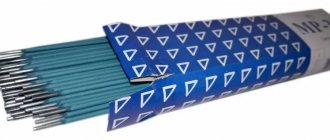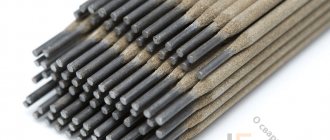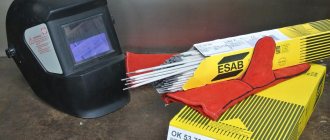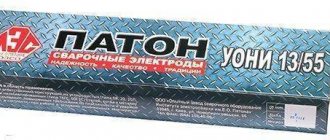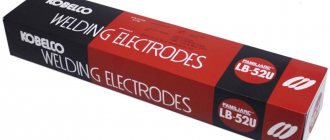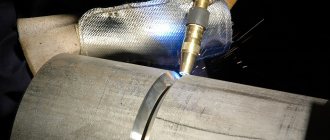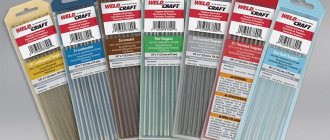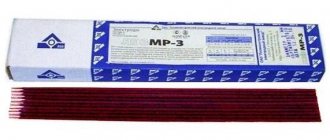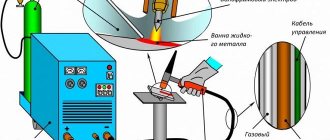Welding electrodes should be divided according to their purpose, the composition of the coating (its type), and methods of use (the type of welding current used). The principles of welding with coated rods are based on melting them using an electric current. In this case, the coating material simultaneously turns into a mixture of gases and protective slag, which protect the welding zone. The composition of the metal of the rod depends on the composition of the parts being welded: it can be steel, cast iron, a mixture of copper or aluminum with other (auxiliary) elements.
Brands of electrodes for steel welding
Since there are dozens of types of steels, it means that the same number of electrodes have been developed for them. To weld steel with electrodes, you must have manual arc welding skills, select suitable electrodes and know the characteristics of the metal itself. We will talk about all this further.
Most often on store shelves you can find electrodes for welding carbon steels. And all because this metal is used most often. Therefore, any more or less large manufacturer produces electrodes for welding carbon steel. The most common brands are MR, UONI, OZS and ANO. Let's take a closer look at exactly what types of these grades are used for steel.
By coverage
In total, there are four separate types of coating (basic, rutile, cellulose, acidic) and their combinations. The coating protects the weld pool from contact with the external environment and additionally saturates the metal with the necessary elements.
Rutile
The most common are rutile electrodes, which are often used by welders in enterprises. Examples of brands of consumables with rutile coating are: ANO-21, OK-46, MP-3, etc. They are suitable for welding gates, wickets, fences, greenhouses, canopies, canopies and other structures.
Rods with rutile coating are suitable for direct and alternating current, welding in all spatial positions, except vertical downhill. Among the advantages of using such consumables are the following:
- easy installation of tacks;
- insensitive to changing air gap length;
- ignite well both for the first time and repeatedly;
- not demanding on the cleanliness of the workpiece - can be welded on rusty metal;
- convenient for connecting thin parts;
- form a smooth, even roller;
- slag is easily separated;
- Suitable for intermittent arc welding.
This is the best option for welding at home, in the country or in a workshop. It is best to use short sutures.
Basics
Electrodes with a basic coating are more difficult to ignite, especially repeatedly. You cannot weld with the arc pulled off, otherwise you will have to knock on the product for a long time with the tip of the rod. The sides to be welded must be cleaned of dirt, paint, and rust, otherwise the arc will go out and “spit.” Some electrodes with a basic coating can only be welded using direct current of reverse polarity. But such consumables have the following advantages:
- boil thick metal well;
- the weld pool is clearly visible;
- less slag is released during combustion;
- Excellent for root joints and filling layers;
- the connection has increased tensile strength.
Popular brands of electrodes with basic coating: UONI 13/55, 13/45, 13/65, OK 48.
Such consumables are in demand for welding critical structures, but it will be more difficult for a beginner to use them. Therefore, if there is no production need, choose electrodes with rutile coating.
Sour
Acid-coated electrodes are used for assembling low-critical structures in construction and manufacturing. Designed for all spatial positions, except vertical for descent. They cook well on alternating and direct current, but they spit a lot. Suitable for rolled metal products made from low alloy steel. The arc burns stably, the cost of consumables is minimal, but the strength characteristics of the seams are low.
Pulp
The coating is thinner than the others, which makes it easier to weld in hard-to-reach places through technical holes. Suitable for work in all spatial positions, and therefore often used for installation on construction sites. Promote high quality welds on direct and alternating current. Suitable for welding low-alloy and carbon steels, main pipelines.
Mixed
Combining two coatings allows you to combine their beneficial properties. Possible options include combinations of base and rutile coating, acid and cellulose, rutile and cellulose. The combination of rutile and cellulose coating ensures easy ignition and increased strength characteristics. If you want to try these electrodes, buy ESAB OK 46.00 or RB-26 KOBELCO.
Welding Features
To ensure decent quality of seams, you need to know some of the nuances of welding steels. Of course, we can't list them all, but you'll learn the basics that will make your job easier.
When welding high-carbon steel, it is recommended to preheat the metal to a temperature of no more than 650 degrees. For welding, use contact, gas or arc technology. It is advisable to use fluxes and filler wire. The composition of the wire must be identical to the composition of steel.
To weld austenitic steels, use resistance welding technology using a reduced welding current density.
Dissimilar steels
As for welding dissimilar steels, this too has its own characteristics. Those metals that belong to different classes are considered dissimilar. For example, austenitic steel and pearlitic steel are dissimilar. High-alloy and low-alloy steels are also considered dissimilar. For such work during RDS welding, it is necessary to use special electrodes for welding dissimilar steels. But RDS welding is still not recommended. It is advisable to weld such metals not by electric arc welding, but by laser or plasma. Such technologies require a shallow melting depth of the metal. Therefore, the quality of the seams is much better than with arc welding.
A separate technology was invented specifically for welding pearlitic and austenitic steel. The essence of this technology is simple. A small layer of austenitic steel is fused onto the pearlitic steel part. Then the edges are heated and both parts are welded together. In this case, you need to choose the welding mode that is suitable for the austenitic part.
Use low hydrogen electrodes when welding dissimilar steels. Indeed, with an excess amount of hydrogen, parts begin to form cracks in their initial stages. Also, with an excess of hydrogen, the likelihood of pore formation increases.
Which is better AC or DC?
The answer to this question is quite simple - it is direct current. AC sources have a certain number of advantages, such as low power losses, but the quality of the welding seam with alternating current is lower. This is due to the fact that when welding with alternating current, the arc has zero voltage for a period of 3 times. In fact, it breaks off for a split second and flares up again.
To stabilize the arc, special components are added to the electronic coating that improve ionization. Also, with alternating current, polarity changes 120 times per second at an industrial frequency of 60 Hz, which in turn affects the instability of the welding process.
Let's talk a little about polarity. When using reverse polarity, maximum heating goes to the electrode, which in turn reduces the amount of heat introduced into the part, and this reduces deformation.
When using direct polarity, the situation is reversed; maximum heat is removed into the part, which can provide deeper penetration of the metal and is used for welding parts with large thicknesses. It is also used for TIG welding so as not to introduce additional overheating to the tungsten electrode.
When welding with alternating current, the polarity is straight for half a period, and then reversed, which in turn negatively affects the quality of welding.
Recommendations for beginners
As you can see, welding steel comes with many nuances that you need to be aware of. Beginners are often afraid to take on steel welding, thinking that they will not be able to complete such a complex job. But, believe me, the more experience you have, the higher your professional skills. This means the work itself is easier.
You can avoid complex welding work as much as you like, but you will never learn the main thing. And having a solid base of theory and skills, you can already perform complex welding. Even without enough experience.
Your work will be simplified by the correct selection of electrodes. Are you welding heat-resistant steel? Come to the store and clearly explain to the seller that you need electrodes for heat-resistant steels. This is where you can start. In the future, you will already gain enough experience to choose electrodes yourself without outside help.
According to the requirements for the finished structure
The selection of electrodes for MMA welding depends on the requirements for the finished structure. It could be:
- tensile strength;
- impact strength;
- heat resistance;
- corrosion resistance;
- tensile strength;
- relative extension.
For example, for low-critical structures, a tensile strength of 43 kg/mm² is sufficient, and for products subject to increased loads, electrodes with a tensile strength of 55 kg/mm² are more suitable. Tensile strength is measured in MPa and can range from 380 to 650 or more MPa. Relative elongation is important under temperature changes and mechanical stress and can be 10-45%. Impact strength is measured in J/cm². The lower the temperature, the more fragile the joint becomes.
The resistance of a seam to corrosion is indicated in the marking of electrodes in 5 stages - the higher the number, the better. Heat resistance and heat resistance are indicated in 9 levels, each of which has its own temperature range. You can find out in more detail how to determine these indicators of electrodes by marking in the adjacent article. (here is a link to an article about marking that has not yet been published).
State standard
The key requirements for the physical and chemical properties of steel 20 are contained in GOST 1050-2013. The existing regulatory documents also contain an indication of the form in which this steel should be supplied from the plant - in the form of semi-finished products (coils, sheets) or in the form of finished products (angles, channels, pipes, rods and others available to the manufacturer subject to technological processes).
GOST 1050-2013 “Metal products from unalloyed structural high-quality and special steels” came into force on January 1, 2015 and is intended to carry out interstate regulation of the processes of manufacturing metal products made by hot rolling, forging, calibration, as well as for products with special surface preparation, which will be used in various industries.
Classification of welded joints of dissimilar steels
Thus, welded joints of materials of dissimilar types were divided into 4 groups. The distinction is made depending on the temperature of their operation. Each category has its own optimal value, which is acceptable for the non-austenitic steel used in it:
- 1st group – up to 350°C;
- 2nd – 350-450°C;
- 3rd – 450-550°C;
- 4th – more than 550°C.
Electrodes TsL 9 in a package.
Research has shown that the deposited metal of group 1 compounds must have at least 8% nickel, group 2 – 19%, group 3 – 31%, group 4 – 47%. Accordingly, to create connections that are operated at temperatures up to 350°C, the following brands of electrodes can be used: GS-1, OZL-6, OZL-27 and TsL-9.
Welding consumables OZL-6 provide deposited metal of type E-10Х25НВГ2. TsL-9 electrodes are additionally alloyed with niobium and have a deposited metal type of 10Х25Н13Г2Б. OZL-27 electrodes are additionally supplied with molybdenum and guarantee a deposited metal of the following chemical composition: carbon - 0.18%, silicon - 0.6%, manganese - 1.63%, nickel - 10.3%, chromium - 25.3% , molybdenum – 3.1%. GS-1 materials provide the chemical composition of the following proportions: carbon - 0.09%, silicon - 2.5%, manganese - 6.3%, nickel - 9.4%, chromium - 23.3%.
